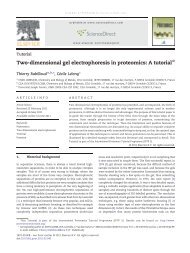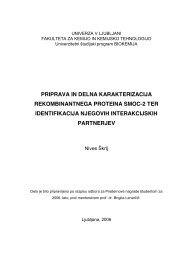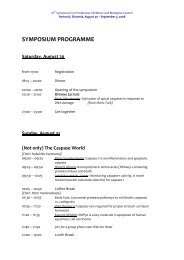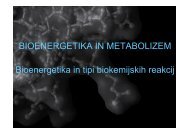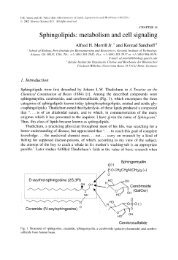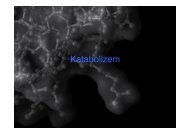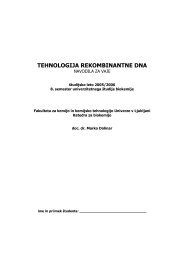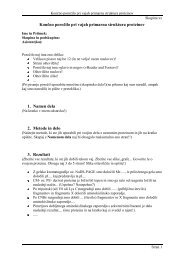Extremophiles as a source of novel enzymes for industrial application
Extremophiles as a source of novel enzymes for industrial application
Extremophiles as a source of novel enzymes for industrial application
Create successful ePaper yourself
Turn your PDF publications into a flip-book with our unique Google optimized e-Paper software.
716<br />
motetramer (56 kDa/subunit) and very resistant to<br />
various denaturants with activity up to 85 °C (Pisani<br />
et al. 1990). The gene <strong>for</strong> this b-glucosid<strong>as</strong>e h<strong>as</strong> been<br />
cloned and overexpressed in E. coli (Cubellis et al. 1990;<br />
Moracci et al. 1993; Prisco et al. 1994).<br />
Xylan-degrading <strong>enzymes</strong><br />
Xylan is a heterogeneous molecule that constitutes the<br />
main polymeric compound <strong>of</strong> hemicellulose, a fraction<br />
<strong>of</strong> the plant cell wall that is a major reservoir <strong>of</strong> ®xed<br />
carbon in nature. The main chain <strong>of</strong> the heteropolymer<br />
is composed <strong>of</strong> xylose residues linked by b-1,4-glycosidic<br />
bonds. Approximately half <strong>of</strong> the xylose residues are<br />
substituted at the O-2 or O-3 positions <strong>of</strong> acetyl, arabinosyl<br />
and glucuronosyl groups. The complete degradation<br />
<strong>of</strong> xylan requires the action <strong>of</strong> several <strong>enzymes</strong> (<strong>for</strong><br />
a detailed description see reviews Sunna and Antranikian<br />
1997a; Sunna et al. 1996a). The endo-b-1,4-xylan<strong>as</strong>e<br />
(EC 3.2.1.8), or b-1,4-xylan xylanohydrol<strong>as</strong>e, hydrolyses<br />
b-1,4-xylosydic linkages in xylans, while b-1,4-xylosid<strong>as</strong>e<br />
or b-xylosid<strong>as</strong>e or b-1,4-xylan xylohydrol<strong>as</strong>e or xylobi<strong>as</strong>e<br />
or exo-b-1,4-xylosid<strong>as</strong>e (EC 3.2.1.37) hydrolyses b-<br />
1,4-xylans and xylobiose by removing the successive<br />
xylose residues from the non-reducing termini. a-Arabin<strong>of</strong>uranosid<strong>as</strong>e<br />
or arabinosid<strong>as</strong>e (EC 3.2.1.55) hydrolyses<br />
the terminal non-reducing a-L-arabin<strong>of</strong>uranoside<br />
residues in a-L-arabinosides. The enzyme also acts on a-<br />
L-arabin<strong>of</strong>uranosides, a-L-arabinans containing either<br />
1,3 or 1,5 linkages. Glucuronoarabinoxylan endo-b-1,4xylan<strong>as</strong>e<br />
or feraxan endoxylan<strong>as</strong>e or glucuronoarabinoxylan<br />
b-1,4-xylanohydrol<strong>as</strong>e (EC 3.2.1.136) attacks<br />
b-1,4-xylosyl linkages in some glucuronoarabinoxylans.<br />
This enzyme also shows high activity towards feruloylated<br />
arabinoxylans from cereal plant cell walls.<br />
Acetylxylanester<strong>as</strong>e (EC 3.1.1.6) removes acetyl groups<br />
from xylan. Xylan<strong>as</strong>es from bacteria and eukarya comprise<br />
families 10 and 11 <strong>of</strong> the glycosyl hydrol<strong>as</strong>es and<br />
have a wide range <strong>of</strong> potential biotechnological <strong>application</strong>s.<br />
They are already produced on an <strong>industrial</strong><br />
scale and are used <strong>as</strong> food additives in poultry, <strong>for</strong> incre<strong>as</strong>ing<br />
feed e ciency (Annison 1992; Cl<strong>as</strong>sen 1996)<br />
and in wheat ¯our <strong>for</strong> improving dough handling and<br />
the quality <strong>of</strong> baked products (Maat et al. 1992).<br />
In recent years, the major interest in thermostable<br />
xylan<strong>as</strong>es lay in enzyme-aided bleaching <strong>of</strong> paper<br />
(Viikari et al. 1994). More than 2 ´ 10 6 tonnes <strong>of</strong> chlorine<br />
and chlorine derivatives are used annually in the<br />
United States <strong>for</strong> pulp bleaching. The chlorinated lignin<br />
derivatives generated by this process constitute a major<br />
environmental problem caused by the pulp and paper<br />
industry (McDonough 1992). Recent investigations have<br />
demonstrated the fe<strong>as</strong>ibility <strong>of</strong> enzymatic treatments <strong>as</strong><br />
alternatives to chlorine bleaching <strong>for</strong> the removal <strong>of</strong><br />
residual lignin from pulp (Viikari et al. 1994). Treatment<br />
<strong>of</strong> craft pulp with xylan<strong>as</strong>e leads to a rele<strong>as</strong>e <strong>of</strong> xylan<br />
and residual lignin without undue loss <strong>of</strong> other pulp<br />
components. Xylan<strong>as</strong>e treatment at elevated tempera-<br />
tures opens up the cell wall structure, thereby facilitating<br />
lignin removal in subsequent bleaching stages. Candidate<br />
xylan<strong>as</strong>es <strong>for</strong> this important, potential market<br />
would have to satisfy several criteria: (1) they must lack<br />
cellulolytic activity to avoid hydrolysis <strong>of</strong> the cellulose<br />
®bres, (2) their molecular m<strong>as</strong>s should be low enough to<br />
facilitate their di€usion in the pulp ®bres, (3) they must<br />
be stable and active at high temperature and at alkaline<br />
pH, and (4) one must be able to obtain high yields <strong>of</strong><br />
enzyme at very low cost. All <strong>of</strong> the xylan<strong>as</strong>es currently<br />
available from commercial suppliers can only partially<br />
ful®l these criteria. Xylan<strong>as</strong>es from moderate thermophilic<br />
microorganisms are rapidly denatured at temperatures<br />
above 70 °C. Several <strong>of</strong> the non-chlorine bleaching<br />
stages used in commercial operations are per<strong>for</strong>med well<br />
above this temperature; consequently, pulp must be<br />
cooled be<strong>for</strong>e treatment with the available <strong>enzymes</strong> and<br />
reheated <strong>for</strong> subsequent processing steps (Chen et al.<br />
1997).<br />
Thermostable xylan<strong>as</strong>es<br />
So far, only a few extreme thermophilic microorganisms<br />
are able to grow on xylan and secrete thermoactive<br />
xylanolytic <strong>enzymes</strong> (Table 2). Members <strong>of</strong> the order<br />
Thermotogales and Dictyoglomus thermophilum Rt46B.1<br />
have been described to produce xylan<strong>as</strong>es that are active<br />
and stable at high temperatures (Gibbs et al. 1995;<br />
Sunna and Antranikian 1997a). The most thermostable<br />
endoxylan<strong>as</strong>es that have been described so far are those<br />
derived from Thermotoga sp. strain FjSS3-B.1 (Simpson<br />
et al. 1991), T. maritima (Winterhalter and Liebl 1995),<br />
T. neapolitana (Bok et al. 1994) and Thermotoga thermarum<br />
(Sunna et al. 1996b). These <strong>enzymes</strong>, which are<br />
active between 80 °C and 105 °C, are mainly cell-<strong>as</strong>sociated<br />
and most probably localized within the toga<br />
(Ruttersmith et al. 1992; Schumann et al. 1991; Sunna<br />
et al. 1996a; Winterhalter and Liebl 1995). Several genes<br />
encoding xylan<strong>as</strong>es have been already cloned and<br />
sequenced. The gene from T. maritima, encoding a<br />
thermostable xylan<strong>as</strong>e, h<strong>as</strong> been cloned and expressed in<br />
E. coli. Comparison between the T. maritima recombinant<br />
xylan<strong>as</strong>e and the commercially available enzyme,<br />
Pulpenzyme (Yang and Eriksson 1992) indicates that the<br />
thermostable xylan<strong>as</strong>e could be <strong>of</strong> interest <strong>for</strong> <strong>application</strong><br />
in the pulp and paper industry (Chen et al. 1997).<br />
Only recently an archaeal xylan<strong>as</strong>e with a temperature<br />
optimum <strong>of</strong> 110 °C w<strong>as</strong> found in the hyperthermophilic<br />
archaeon Pyrodictium abyssi (unpublished data).<br />
Chitin degradation<br />
Chitin is a linear b-1,4 homopolymer <strong>of</strong> N-acetylglucosamine<br />
residues and is the second most abundant<br />
natural biopolymer after cellulose on earth. Particularly<br />
in the marine environment, chitin is produced in enormous<br />
amounts and its turnover is due to the action <strong>of</strong>







